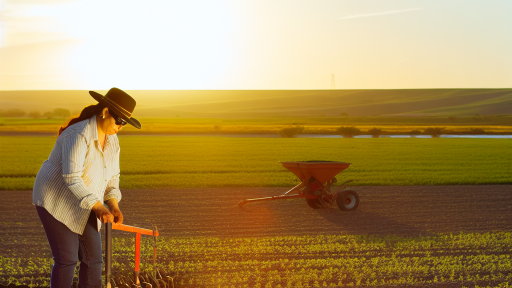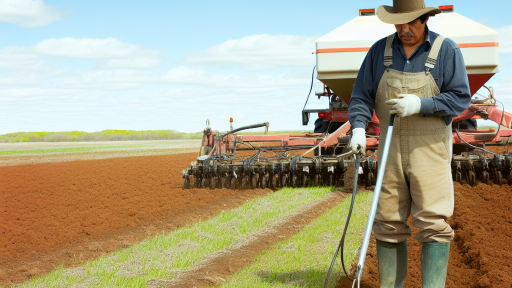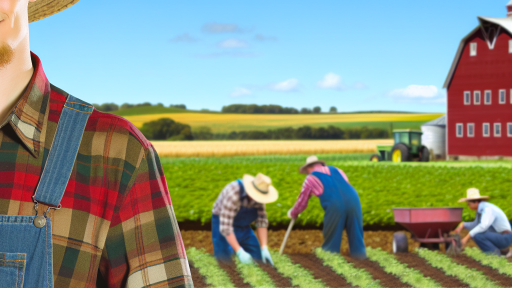Introduction to Natural Pest Control
Naturally controlling pests is essential for organic farming.
It integrates ecological principles into agricultural practices.
This method minimizes chemical use and promotes plant health.
Understanding natural pest control fosters a sustainable environment.
Additionally, it protects beneficial insects and biodiversity.
Importance of Natural Pest Control
Natural pest control methods are vital for maintaining soil quality.
They reduce reliance on synthetic chemicals and fertilizers.
Moreover, these practices enhance resilience against pest outbreaks.
Farmers using natural methods often see improved crop yields.
Furthermore, they contribute to a healthier ecosystem overall.
Benefits for Organic Farming
Organic farming benefits significantly from natural pest control.
It promotes sustainability by maintaining ecological balance.
Natural approaches often lower operational costs over time.
They also improve the safety and quality of food products.
Additionally, customers increasingly prefer organic produce.
Transform Your Agribusiness
Unlock your farm's potential with expert advice tailored to your needs. Get actionable steps that drive real results.
Get StartedThis preference drives market demand and supports local economies.
Understanding Pest Biology
The Importance of Pest Lifecycle Knowledge
Understanding pest biology is crucial for effective pest management.
Pests have distinct life cycles that influence their behavior.
Each stage of a pest’s lifecycle presents unique vulnerabilities.
By knowing these stages, farmers can choose strategic intervention times.
Stages of Pest Development
Pests typically undergo various developmental stages.
Common stages include egg, larva, pupa, and adult.
Identifying these stages helps in selecting appropriate control methods.
Targeting Vulnerable Lifecycle Stages
Targeting the vulnerable stages can prevent future infestations.
For example, treating eggs can reduce the number of young pests.
Applying treatments during the larval stage can maximize effectiveness.
Moreover, understanding timing enhances overall pest control success.
Monitoring Pest Populations
Regular monitoring of pest populations aids in lifecycle understanding.
Farmers should observe pest behaviors and population changes.
This information guides timely interventions based on lifecycle stages.
Integrating Knowledge into Pest Control Strategies
Integrating pest biology knowledge into control strategies is essential.
This holistic approach combines methods for best results.
Farmers should utilize traps, natural predators, and organic pesticides.
Such methods align with the lifecycle stages for optimal control.
Cultural Practices: Crop Rotation and Intercropping
Understanding Crop Rotation
Crop rotation involves changing the type of crops grown in a specific area each season.
This practice disrupts pest life cycles effectively.
Furthermore, rotating crops can enhance soil nutrients naturally.
It also improves soil structure and promotes biodiversity.
Benefits of Crop Rotation on Pest Populations
Different crops attract different pests.
Showcase Your Farming Business
Publish your professional farming services profile on our blog for a one-time fee of $200 and reach a dedicated audience of farmers and agribusiness owners.
Publish Your ProfileBy rotating crops, farmers can reduce pest populations significantly.
For instance, planting legumes can help control root-feeding nematodes.
This practice can minimize the need for chemical pesticides.
As a result, crop rotation leads to healthier, more resilient ecosystems.
Exploring Intercropping
Intercropping involves growing two or more crops in proximity.
This method can confuse pests and reduce infestations.
For example, planting corn with beans can improve pest resistance.
Additionally, intercropping promotes maximum land utilization.
Effects of Intercropping on Pest Management
Intercropping naturally decreases pest outbreaks.
It also fosters beneficial insect populations, like predatory beetles.
These insects play a crucial role in pest control.
Moreover, nutritional competition between crops can limit pest reproduction.
Consequently, intercropping can enhance overall crop yields.
Combining Practices for Optimal Results
Integrating crop rotation and intercropping maximizes pest control benefits.
This combined approach can significantly improve crop health.
Farmers can create more resilient farming systems through these practices.
Both methods encourage biodiversity and soil health.
Ultimately, they provide sustainable alternatives to chemical pest control.
You Might Also Like: Companion Planting Tips for Organic Crop Success
Biological Control Agents
Introduction to Biological Control
Biological control agents are natural predators or parasites of pest species.
These agents help maintain pest populations at manageable levels.
Using biological control reduces the reliance on chemical pesticides.
Beneficial Insects
Beneficial insects play a crucial role in organic pest management.
Common beneficial insects include ladybugs, lacewings, and parasitoid wasps.
Ladybugs effectively consume aphids and other soft-bodied pests.
Lacewings feed on aphids, mealybugs, and thrips, keeping populations down.
Parasitoid wasps lay their eggs inside pest insects, leading to their decline.
Creating a Habitat for Beneficial Insects
To attract beneficial insects, create diverse habitats in your garden.
Include flowering plants that provide nectar and pollen.
Consider planting herbs like dill, fennel, and coriander.
Providing shelter, such as insect hotels, encourages beneficial insects.
Microorganisms in Pest Control
Microorganisms, like fungi and bacteria, also serve as biological control agents.
Entomopathogenic fungi infect and kill pest insects effectively.
For example, Beauveria bassiana targets various pests, including beetles and caterpillars.
Bacillus thuringiensis (Bt) is a bacterium that specifically targets caterpillars.
Utilizing Microorganisms in Your Garden
Applying these microorganisms can help reduce pest populations safely.
Ensure to follow application guidelines for best results.
Combine microbial treatments with other pest management strategies for effectiveness.
Complementary Strategies
Integrating beneficial insects and microorganisms enhances pest control efforts.
Crop rotation can disrupt pest life cycles and reduce infestations.
Showcase Your Farming Business
Publish your professional farming services profile on our blog for a one-time fee of $200 and reach a dedicated audience of farmers and agribusiness owners.
Publish Your ProfileChoosing pest-resistant plant varieties strengthens your defense against pests.
Monitoring and Assessment
Regular monitoring of pest populations allows timely interventions.
Identify pest types and appropriate biological control measures for success.
Maintaining a balance between beneficial and harmful species is essential.
Learn More: Top Organic Farming Techniques for Successful Harvests
Physical Barriers: Using Mulches, Row Covers, and Traps to Protect Crops
Understanding Physical Barriers
Physical barriers effectively protect crops from pests and environmental stressors.
They create a defense system that prevents direct contact with harmful organisms.
As a result, crops can grow healthier and yield better produce.
Utilizing Mulches
Mulches cover the soil and provide numerous benefits for crop protection.
They suppress weed growth, which competes for essential nutrients.
Additionally, mulches conserve soil moisture, reducing irrigation needs.
They can also deter certain pests by creating barriers on the soil surface.
Organic mulches, such as straw or wood chips, attract beneficial insects.
Implementing Row Covers
Row covers are lightweight fabrics placed over crops.
They protect plants from harmful insects while allowing sunlight and moisture in.
These covers help maintain optimal temperature and humidity for crop growth.
Furthermore, they prevent direct damage from harsh weather conditions.
Use row covers to extend the growing season for sensitive crops.
Employing Traps
Traps effectively monitor and manage pest populations in the field.
They catch harmful insects, reducing their numbers before they can cause damage.
Sticky traps are particularly useful for capturing flying pests.
Additionally, pheromone traps attract pests, aiding in their management.
Integrating traps into your pest control strategy enhances overall crop health.
Combining Techniques
Combining various physical barrier methods increases crop protection effectiveness.
For example, using both mulches and row covers can provide dual defense.
Moreover, incorporating traps within these systems offers a comprehensive approach.
This layered strategy fosters an environment where crops can thrive.
Ultimately, using physical barriers aligns with sustainable organic farming practices.
Find Out More: Types of Cover Crops and Their Uses
Plant Companionship
The Benefits of Companion Planting
Companion planting effectively deters pests and enhances crop health.
This method involves planting compatible plants together.
It maximizes space and promotes biodiversity in your garden.
Common Companion Plant Pairings
Certain plants work exceptionally well together.
- Basil repels mosquitoes and attracts beneficial insects.
- Marigold deters nematodes and various harmful pests.
- Nasturtium attracts aphids away from more vulnerable plants.
- Garlic can repel snails and other unwanted pests.
Tips for Successful Companion Planting
Choose plants based on their growth habits and nutrient needs.
Plant taller species to provide shade for shorter plants.
Utilize legumes to enhance soil nitrogen levels naturally.
Always observe the interaction between different plants.
Adjust combinations as needed for the best results.
Challenges of Companion Planting
Maintaining the right balance is crucial for success.
Some plants may outcompete others for resources.
Showcase Your Farming Business
Publish your professional farming services profile on our blog for a one-time fee of $200 and reach a dedicated audience of farmers and agribusiness owners.
Publish Your ProfileRegular monitoring helps address any issues early.
Impacts of Companion Planting on Sustainable Practices
Embracing the art of companion planting fosters a naturally balanced ecosystem.
This method enhances crop yields and maintains sustainable practices.
Gain More Insights: Top Cover Crops to Prevent Soil Erosion

Natural Pesticides: Overview of Plant-Based Solutions and Their Applications
Introduction to Natural Pesticides
Natural pesticides are derived from plants and minerals.
They serve as effective alternatives to synthetic chemicals.
This section explores their diverse applications in organic farming.
Types of Natural Pesticides
Several types of natural pesticides exist, including essential oils.
Neem oil is a popular solution for pest management.
Another option is diatomaceous earth, effective against crawling insects.
In addition, garlic and chili sprays deter unwanted pests.
Each type offers unique benefits for crop protection.
How to Use Natural Pesticides
Applying natural pesticides requires specific techniques for effectiveness.
First, always read the instructions on the product label.
Next, consider timing your application to coincide with pest activity.
Applying early in the morning or late in the evening reduces harm to beneficial insects.
For best results, repeat applications may be necessary after rain or irrigation.
Benefits of Using Plant-Based Solutions
Utilizing natural pesticides enhances soil health and biodiversity.
They minimize the risk of pesticide resistance in pest populations.
Additionally, natural pesticides are often safer for human health.
These solutions contribute to sustainable agricultural practices.
Challenges and Considerations
Natural pesticides may not offer immediate results compared to synthetic options.
Farmers must monitor pest levels carefully and adjust applications accordingly.
Moreover, some natural pesticides can harm beneficial insects if misapplied.
Therefore, understanding the ecological impact of each product is crucial.
Monitoring and Assessment
Identifying Pests
Effective pest management begins with accurate pest identification.
Farmers should regularly inspect their crops for signs of infestation.
Look for visible damage on leaves, stems, and fruit.
Identifying pest species enables targeted control measures.
Using integrated pest management tools can enhance identification efforts.
Some common pests include aphids, spider mites, and beetles.
Utilize field guides and online resources for accurate identification.
Involve local agricultural extension services for expert advice.
Evaluating Pest Populations
Once pests are identified, evaluate their population levels.
Monitor pest numbers using trapping techniques.
Regular sampling helps determine infestation severity.
Use tools like sticky traps or pheromone traps for monitoring.
Assess whether pest populations exceed established action thresholds.
Document findings to track pest populations over time.
This data informs decision-making for pest control strategies.
Showcase Your Farming Business
Publish your professional farming services profile on our blog for a one-time fee of $200 and reach a dedicated audience of farmers and agribusiness owners.
Publish Your ProfileMonitoring Control Effectiveness
After implementing control measures, evaluate their effectiveness.
Continue monitoring pest populations following treatments.
Determine if populations decline or if they remain stable.
Adjust strategies based on observed outcomes and effectiveness.
Maintain clear records of pest control methods and outcomes.
Regularly reviewing this information enhances future management plans.
Collaboration with other farmers can provide valuable insights.
Share successes and failures to build a community knowledge base.
Challenges and Considerations
Limitations of Natural Pest Control
Natural pest control offers numerous benefits for organic agriculture.
However, it also presents several challenges that farmers must navigate.
First, effectiveness can vary significantly based on pest species.
Some pests may resist natural control methods more than others.
This can lead to inconsistent pest management results in the field.
Additionally, the timing of pest control is critical for success.
Pests often emerge at unpredictable times, complicating control efforts.
Farmers may struggle to apply natural methods when pests are most active.
Moreover, the availability of beneficial organisms can be limited in rural areas.
This scarcity may hinder the implementation of certain natural pest control strategies.
Furthermore, the integration of natural controls with conventional methods can be complex.
Farmers need to balance chemical and natural approaches effectively.
This requires careful planning and timing throughout the growing season.
Economic Factors
Cost is another significant consideration in natural pest control.
While organic methods can be beneficial, they may involve higher upfront costs.
Investments in beneficial insects or organic pest deterrents can add expenses.
Additionally, the yield losses due to ineffective control methods can impact profitability.
Farmers must evaluate whether natural methods can sustain their farms economically.
Knowledge and Expertise
Knowledge about effective natural pest control strategies is essential.
Farmers may require training to understand complex ecosystem interactions.
Some natural methods necessitate specific expertise to be effective.
Consequently, ongoing education and support can help overcome this barrier.
Collaboration with agricultural experts can significantly enhance pest management.
By sharing knowledge, farmers improve their pest control outcomes.
Regulatory Considerations
Compliance with organic standards adds another layer of complexity.
Farmers must ensure that their pest control methods meet organic regulations.
This can limit the options for certain natural pest control techniques.
Staying updated on regulations is crucial to maintain organic certification.
Each farmer should thoroughly document their pest management practices.
Additional Resources
Organic 101: What the USDA Organic Label Means | USDA
Organic Gardening Pest Control: Natural Methods for Managing …




